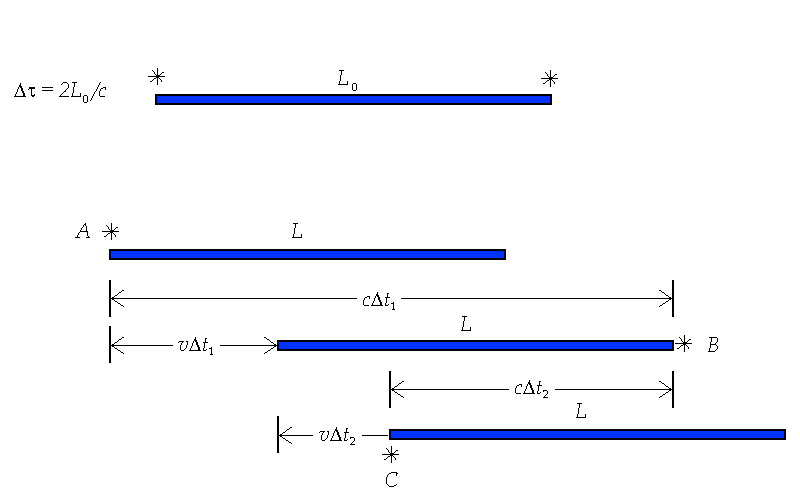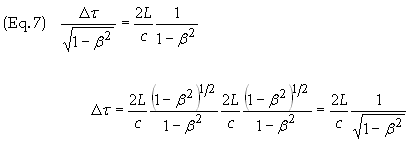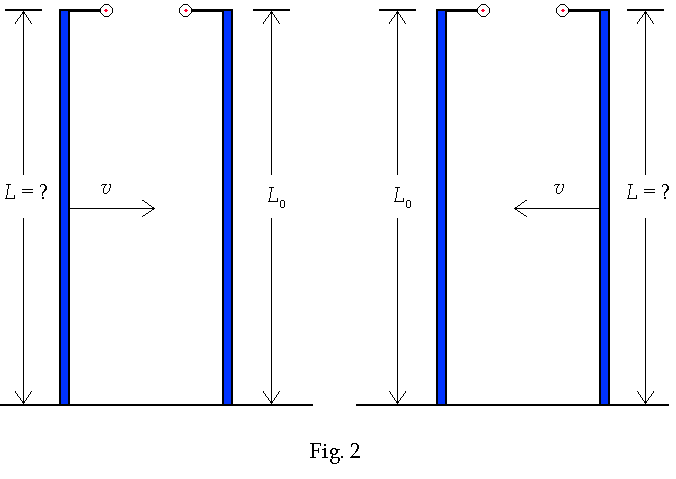
Lorentz
Contraction
Back
to Physics World
Back to Special Relativity
Measure
Length Parallel to Motion
In an
inertial frame of reference consider a rod having a length L0
as measured in the frame in which the rod is at rest. A clock is located at one
end. Consider the following events:
Event
A: A flash of
light is emitted at the end of the rod where the clock is located.
Event
B: Flash of light
arrives at the opposite end off the rod.
Event
C: Flash of light
arrives at the same end of the rod that it was emitted.
The
sequence of events tells a simple story. Light leaves one end of the rod. The
light travels to the opposite end of the rod where it is reflected. The
reflected light travels back along the same direction in originated from ending
up back where is started. See Fig. 1 below

The
amount of time, Dt,
recorded on the clock will be
![]()
Now
consider these events from a frame of reference in which the rod is moving with
velocity v in the direction parallel to the length of the rod. In this frame we use clocks and rods that are at rest and
therefore moving with respect to the rod. The sequence of events is shown in the
bottom section of the Fig. 1. The time between Event A and Event B is Dt1.
The time between Event B and Event C is Dt2.
The time between Event A and Event C is therefore
![]()
From the
Fig. 1 we can see that
![]()
Solving
for Dt1
and Dt2
gives

Substituting
into Eq. (1) gives

b
º v/c. The time between these events as measured
in the moving frame, Dt,
is related to the time in the rest frame,
Dt, according to the time
dilation relation
![]()
Equating
Eq. (5) and (6) gives

We can
now substitute Eq. (1) in to give

Solving
for L0
gives our final result
![]()
Since g
is always greater than or equal to one for v > 0 it follows that a
moving rod is shorter than the same rod at rest. This phenomenon is known as Lorentz
contraction.
Measure Length Perpendicular to Motion
The
discussion above assumes that the rod is aligned parallel to its velocity.
However if the rod is aligned perpendicular to the velocity then we can take
another, rather easy, approach. We
can use symmetry arguments. Consider two rods, one at rest and the other moving
with velocity v as shown in the Fig. 2

We wish to find L. Think of two rods of identical construction and as such they have the exact same length as measured when they are at rest. The rods are perpendicular and arranged as shown in Fig. 2. Choose a frame of reference in which one rod is at rest and the other rod moves with velocity v towards the other. Let each have a laser attached to the top aligned so that when the rods pass the laser can mark the other rod. If the moving rod has a length greater than L0 then the rod at rest will mark it with the laser. The stationary rod will have not mark since the laser on the other rod passed over its top. However if we view this from the frame of reference in which the moving rod is at rest then rod that was at rest will be moving. According to the principle of relativity there is no preference of one situation over the other since there is perfect symmetry between the two. However this means that the rod now at rest would never have been marked! We can conclude from this that one rod is neither longer nor shorter than the other while in motion – the lasers will burn each other. Therefore the lengths perpendicular to motion do not contract!